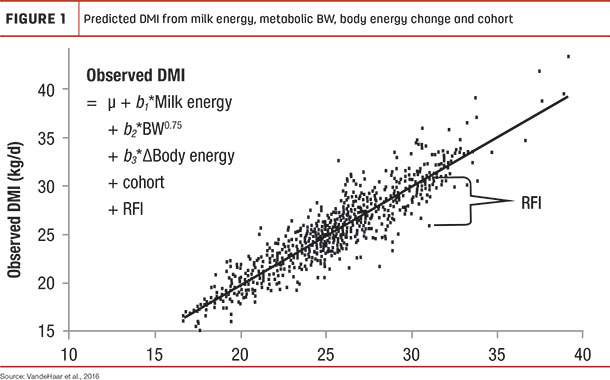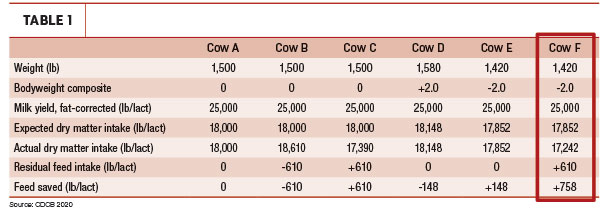Historically, improved production efficiency has also improved feed efficiency, but producers expect and deserve new tools to continue this progress.
Starting Dec. 1, 2020, producers will be able to breed for more feed-efficient cows, when the Council on Dairy Cattle Breeding (CDCB) will publish a new genetic trait for Holsteins: Feed Saved.
While it’s been of genetic interest for several years, the feed efficiency of individual animals is a difficult trait to measure and evaluate. Our goal is to identify the specific cows that eat less than we expect based on nutritional standards, production level and body size. To develop genetic evaluations of Feed Saved, we must first have a population of cows with the necessary data measured – daily feed intake, milk yield, milk composition, bodyweight and body condition score.
Collaboration in data collection
A team of global leaders in dairy nutrition, management, population genetics and genomics began this foundational work in 2010 through a USDA National Institute of Food and Agriculture grant. A database of genotypes and phenotypes (performance data) for 5,000 U.S. Holstein cows was compiled during this project, with data collected from multiple locations throughout the country. Research indicated that feed efficiency has a heritability of approximately 14%, which is mid-range relative to other traits. However, the trait has low average reliabilities given the small number of animals with actual data on feed intake and related factors.
Results of this research also indicated that Feed Saved could save the dairy industry $540 million per year in feed costs alone, with no loss in milk production.
To increase the reliability of feed efficiency evaluations, a second phase of this research is underway through funding from the Foundation for Food and Agriculture Research and the CDCB. Scientists located at five institutions throughout the U.S. are collecting more feed efficiency data and continuing to research this important trait. Participating researchers include Mike VandeHaar and Rob Tempelman (Michigan State University); Kent Weigel and Heather White (University of Wisconsin – Madison); James Koltes (Iowa State University); José Santos and Francisco Peñagaricano (University of Florida); and Randy Baldwin, John Cole and Paul VanRaden (Animal Genomics and Improvement Laboratory, USDA). This project plans to collect phenotypes on an additional 3,600 cows over five years.
The CDCB will launch Feed Saved with the Dec. 1, 2020, genetic evaluations based on a current database of more than 6,300 Holstein cows with feed efficiency records. Feed Saved will represent a combination of Predicted Transmitting Abilities (PTAs) for Body Weight Composite (BWC) and Residual Feed Intake (RFI).
BWC combines stature, strength, body depth, dairy form and rump width. It is presently included in the Net Merit index with a negative relative weight. Research has previously concluded that selecting against BWC will result in more efficient cows.
RFI is the difference between a cow’s expected feed intake and her actual feed intake, after accounting for factors such as production, size and change in bodyweight. Simply, we want to identify those animals that eat less than what we would predict while maintaining production.
Feed Saved: One number for genetic selection
The Feed Saved trait simplifies genetic selection into a single value indicating an animal’s expected feed efficiency. Feed Saved will be expressed as the expected pounds of feed saved per lactation, with larger positive values representing more pounds of feed saved and indicating a more feed-efficient animal. The December 2020 evaluations will include Feed Saved as an individual trait for Holsteins. It is expected that Feed Saved will be included in the Net Merit index when it is next revised in April 2021.
Reliabilities for Feed Saved will be lower on average than other traits currently evaluated due to the limited phenotypes currently available. In comparison, production traits can be predicted with high reliability because phenotypes such as milk yield have been collected for many decades, resulting in a very large population with performance data. The current research project will allow additional phenotypes to be collected, which will increase the reliability of Feed Saved. There is also an effort for this project to use cows that are closely related to current popular sires, which will also help to improve reliabilities for those cow families.
Despite low reliability, inclusion of Feed Saved as a selection criterion will have a significant economic impact for dairy producers and the dairy industry. Currently, genetic gain savings by selecting for Net Merit breeding value is approximately $50 per cow per year. Incorporating Feed Saved into this overall selection objective will allow producers to make 1% further progress. While this seems like a small number, expanded to the 9 million dairy cows in the U.S., it equates to $4.5 million in additional genetic progress for the U.S. dairy industry.
An example Feed Saved comparison
For an example, let’s take six healthy cows, all in the same herd and producing at the same level (Figure 1).

The cows’ bodyweights and BWC vary. We will assume that one unit of BWC equates to 40 pounds of cow weight and requires 74 more pounds of feed per lactation. The expected intake per lactation differs for each cow based on her size. Cow B ate 2 pounds per day more than expected throughout the 305-day lactation period, resulting in 610 additional pounds of RFI. Cows C and F ate 2 pounds per day less than expected, for a 610 savings.
The RFI is the difference between each cow’s expected and actual intake; positive values are desirable.

Considering that BWC and RFI are the factors in each cow’s Feed Saved value, Cow F is the most efficient, as she is smaller in size and consumes less feed than expected while producing the same amount of milk.
Direct selection for feed efficiency can improve dairy farm profitability. The new Feed Saved genetic evaluations provide producers with a new tool to breed more efficient animals. Genetic selection for feed efficiency can also support the dairy industry’s goals to reduce its environmental footprint. More efficient cows require fewer natural resources in cropping and feed processing to produce the same high-quality products that consumers expect. Additionally, several studies have indicated cows that are more feed-efficient also produce less greenhouse gases in the form of methane. The introduction of the Feed Saved evaluation is an exciting step toward more efficient and sustainable dairy production. ![]()
PHOTO: Photo by Mike Dixon.
References omitted but are available upon request. Click here to email an editor.
Kristen Parker Gaddis is a geneticist with The Council on Dairy Cattle Breeding. Email Kristen Parker Gaddis.






